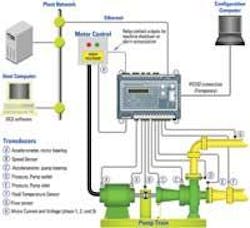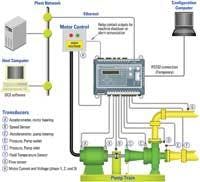Harmonic Convergence: Monitoring the ‘Pulse’ of Pump Systems & Other Rotating Equipment
By Jim McGuinness
Inadequate (or nonexistent) monitoring practices are one of the main reasons why pump failures are missed. Expensive monitoring systems may work well for critical rotating equipment whose failure might create serious accidents or put an entire processing plant or local community at risk, but what about the non-critical, or essential, rotating equipment? Failure of these pumps, motors and mixers is far more common and means unplanned plant downtime, loss of productivity and late nights for everyone at a facility. To remain competitive, companies must improve condition monitoring for their essential equipment.
This is particularly important for industrial facilities where progressively failing equipment may mean lower quality products or sudden failures that affect production schedules. In either case, it costs manufacturers money and profits because of situations that are avoidable with advanced monitoring and instrumentation.
Maintenance engineers need to have all their fluid handling equipment, such as centrifugal pumps, magnetic drive pumps, canned motor pumps and their associated motors continuously monitored. This goes the same for other rotating equipment such as mixers, blowers, compressors and other motor-driven equipment. Advances in technology now provide a much more cost effective way to monitor this equipment through a continuous real-time approach. These new technologies provide a constant stream of machine condition and process data, pinpointing characteristics that predict potential failure, to provide a more accurate view of when maintenance is required, and to alert staff of potential problems.
Continuous monitoring reveals conditions, such as phase imbalance or motor overload, that might produce a failure not seen by intermittent electrical and mechanical monitoring. The traditional approach of employing sporadic condition monitoring through portable equipment and contract reliability professionals isn’t only expensive but leaves large spans of time when equipment is not being monitored. Repairs may be scheduled too infrequently, creating a dangerous work environment by over stressing the rotating equipment and risking a breakdown.
New approaches to combining traditional vibration sensing with electrical sensing allows proactive rotating equipment monitoring solutions that offer plant design and maintenance engineers the option of placing multiple monitoring devices across a facility to gather continuous, real-time data on essential rotating equipment used in their processes.
This continuous data stream of both mechanical and electrical parameters provides real-time information about the total condition of equipment in a facility, so that both operators and maintenance staff can now monitor each piece of rotating equipment. Operators are given a tool to allow them to run their equipment on the performance curve to maximize plant output and, at the same time, maintenance staff is provided continuous data to improve equipment performance and life.
Creating a more efficient maintenance schedule by analyzing continuous vs. intermittent, machine conditioning data means maintenance costs and resources can be optimized. Intervening planned maintenance schedules, based on real-time data, exposes potential problem conditions before they have a chance to develop into a costly breakdown. Repairs can be scheduled so that the problem doesn’t persist and potentially cause system upsets on other equipment in the process. This real-time response dramatically improves the performance and life of pumps, motors and other rotating equipment.
Condition monitoring systems that include both electrical and mechanical monitoring provide broader coverage than traditional vibration monitoring equipment that only address mechanical factors such as bearing malfunction, rotor and stator failure. The stator is the non-moving part of the electric motor that surrounds the rotor. It consists of an iron core with wire windings.
Monitoring of only the vibration for both the equipment structure and the rolling element bearings only provides the maintenance specialist with data on the effects of a problem, leaving the cause to trial and error. A significant percentage of motor-driven equipment failures are only detectable through electrical monitoring since these problems occur inside the motor. Monitoring these electrical characteristics can help find problems, such as motor overload, phase imbalance or even improper wiring - and increase the chances of avoiding unplanned downtime.
Monitoring mechanical and electrical conditions not only identifies the root problems of equipment used in a manufacturing or processing facility, but data generated can also be integrated with distributed control systems (DCS) to provide critical process information throughout the entire facility, such as flow, pressure, temperature, etc. For example, an alarm on a pump or motor may be an indication of an obstruction at air or fluid intake or outsource points.
Technologies that allow real-time condition monitoring provide a higher level of information, both alerting operators and engineers to critical problems, and delivering a broader base of information. New models for plant operations and optimizing maintenance operations for pumps and motors can be created based on a continuous flow of process data. Improvements in these technologies have now made the use of real-time condition monitoring cost effective for rotating equipment, making any facility more secure and a company more profitable.
About the Author:
Jim McGuinness is a program manager for Texas Instruments Sensors & Controls in Attleboro, Mass. Texas Instruments Sensors & Controls serves the industrial, aerospace, lighting and appliance markets with advanced protection controls such as motor protectors, arc fault circuit protection systems, circuit breakers, light commercial gas ignition controls and large commercial HVAC/R system controls. These technologies help prevent damage caused by overheating and fires. TI has over 60 years of experience in the motor industry. For more information, visit www.ti.com/snc. Contact: 508-236-2402 or [email protected].


